Improving Retention Rates for New Hires
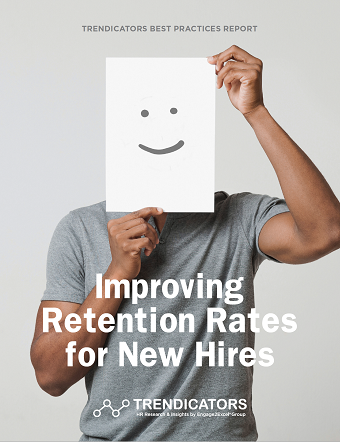
Early attrition is the voluntary departure of new employees
within the first 120 days of employment
TYPES OF TURNOVER
Voluntary: When employees leave by their own choice
Involuntary: When employees are let go
Internal: When employees move to another department
Demographic: When a specific group (age, gender, ethnicity) leaves
Introduction
In the post-pandemic work environment, early attrition has become a problem that many organizations struggle to address. Record low unemployment, changes in work attitudes and expectations, and the high cost of replacing people who quit have made retention strategy a high priority for HR leaders.
Recently, Darren Findley, president of Engage2Excel Recruitment Solutions, led a roundtable discussion about improving retention rates for new hires with the Trendicators Advisory Board. Darren shared insights on voluntary attrition trends, causes and business impacts, which led to a lively discussion with board members. Based on his three decades of recruiting experience, he also recommended what organizations need to build early retention programs.
This report summarizes key takeaways from the roundtable discussion and serves as a practical guide to how organizations can create optimal experiences for candidates and new hires that reduce early attrition.

“Early attrition is a problem that not only increases the cost of talent acquisition, it negatively impacts overall organizational performance and erodes the fabric of corporate culture.”
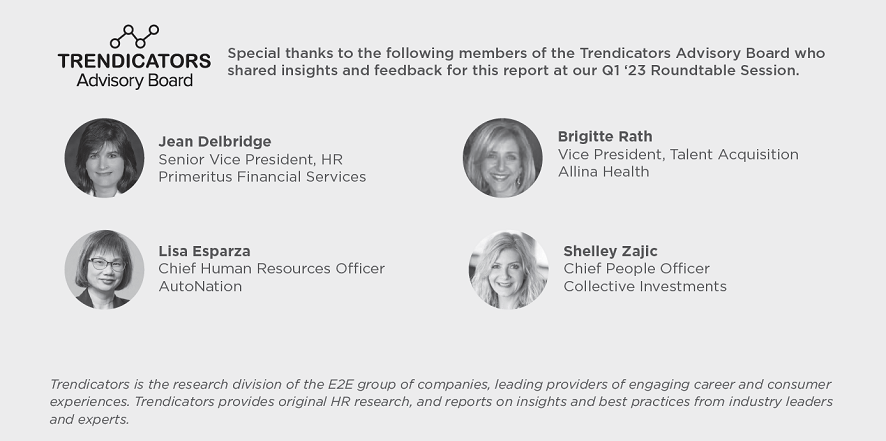
Download
 hbspt.cta.load(123973, 'dec7014e-ac0a-49d2-ae23-b742ac4d9e97', {"useNewLoader":"true","region":"na1"});
hbspt.cta.load(123973, 'dec7014e-ac0a-49d2-ae23-b742ac4d9e97', {"useNewLoader":"true","region":"na1"});
Voluntary Turnover Overview
Annual voluntary turnover rates vary widely by industry (Figure 1). Every month, 3.5–4 million employees (approximately 2% of the workforce) quit their jobs. The average voluntary turnover rate across all industries is 25%. While early turnover rates are not widely reported, Gartner estimates that 20% of all employees quit within their first six months. A LinkedIn survey reported that more than a quarter of Gen Z employees say a lack of learning opportunities is their #1 reason for quitting.
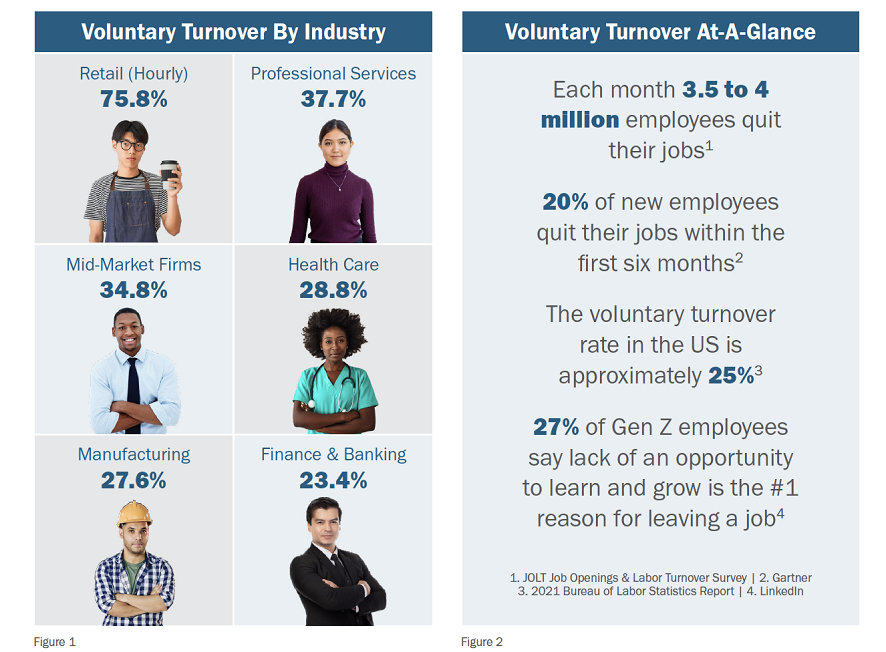
Download
 hbspt.cta.load(123973, 'dec7014e-ac0a-49d2-ae23-b742ac4d9e97', {"useNewLoader":"true","region":"na1"});
hbspt.cta.load(123973, 'dec7014e-ac0a-49d2-ae23-b742ac4d9e97', {"useNewLoader":"true","region":"na1"});
Why Are Employees Quitting Early?
For some employers, voluntary turnover is simply seen as the cost of doing business. Others, however, recognize early turnover as a costly problem that can and should be addressed.
A retention strategy is vital for building and maintaining a strong corporate culture and goes well beyond offering competitive wages and benefits. People want to feel good about their work, be recognized for their contributions, receive opportunities to develop new skills and advance their careers.
A recruitment and talent management expert, Darren Findley believes that many root causes of early attrition (Figure 3) are infinitely addressable via greater attention to the entire new hire experience.
Ensuring the right job fit is a fundamental responsibility for recruiters. Communication and engagement after offer acceptance are vital. Our 2022 survey of candidates revealed that 61% would consider another job offer if not contacted between the time of offer and the first day on the job. Nearly three-quarters believe their first-day onboarding experience affects their decision to stay for more than a month. Inadequate training increases time to productivity and reduces job satisfaction. Employees who feel ignored and unrecognized for achievements early in their tenure seek career development elsewhere.
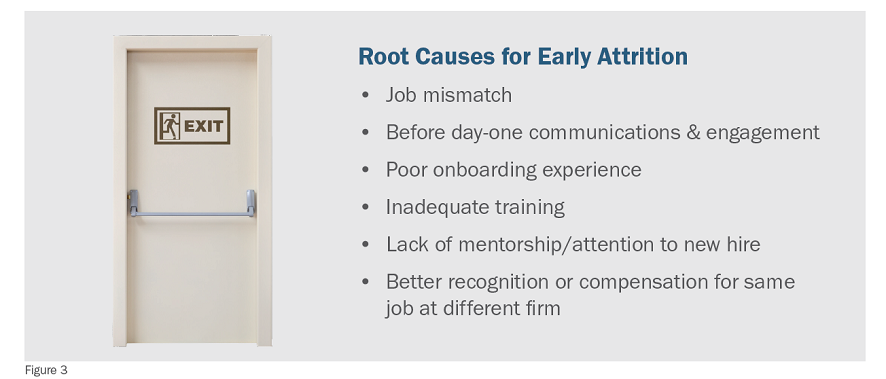
Download
 hbspt.cta.load(123973, 'dec7014e-ac0a-49d2-ae23-b742ac4d9e97', {"useNewLoader":"true","region":"na1"});
hbspt.cta.load(123973, 'dec7014e-ac0a-49d2-ae23-b742ac4d9e97', {"useNewLoader":"true","region":"na1"});
Job Quitters Are Switching Industries
Hardship and isolation endured by many during the pandemic gave rise to behaviors and attitude changes that pose significant challenges for employers. Research by McKinsey & Company (Figure 4) reveals that nearly half the people who quit their job between April 2020 and April 2022 did not return to the same industry. Over a third quit but remained in the same industry, while 17% did not return to the workforce.
What’s behind the big switch? McKinsey identified three groups of dissatisfied workers leaving traditional employment: re-shufflers, re-inventors and re-assessors. Re-shufflers are moving to different industry sectors. Re-inventors are starting their own businesses, joining the fast-growing gig economy or taking part-time roles. And re-assessors are quitting because of their life demands, including caring for children or elders. Figure 5 shows the sectors with the highest rates of employees who either quit and switched industries or left the workforce.
Are people who quit happy about their workplace decisions? There are conflicting reports on the answer to this question. A January 2023 study by EdTech company Cengage reports that 85% are satisfied in their new roles and most (81%) do not regret resigning. A recently released Paychex survey showed that eight of ten workers who quit during the Great Resignation regretted it, including an overwhelming 89% of Gen Zers. Despite these vastly different perspectives, understanding and addressing why people quit is key to improving retention.
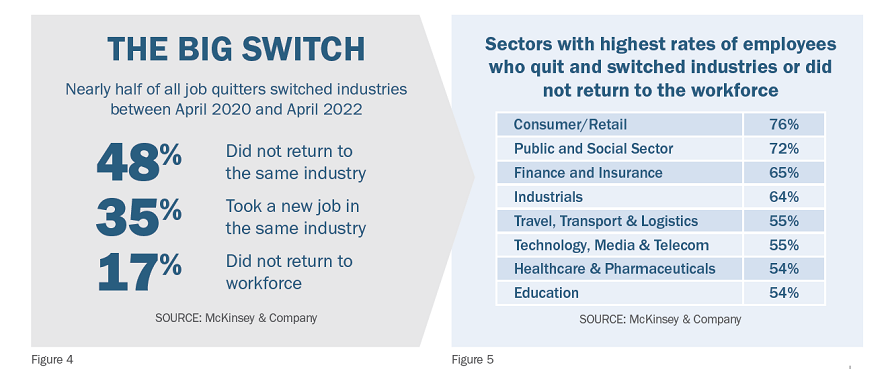
Download
 hbspt.cta.load(123973, 'dec7014e-ac0a-49d2-ae23-b742ac4d9e97', {"useNewLoader":"true","region":"na1"});
hbspt.cta.load(123973, 'dec7014e-ac0a-49d2-ae23-b742ac4d9e97', {"useNewLoader":"true","region":"na1"});
The Business Impacts of Early Attrition
One challenge in addressing the problem of early attrition is the absence of ownership and accountability for improving the return-on-investment (ROI) every company makes in hiring and developing new talent. The cost-to-value diagram in Figure 6 charts the path of a new hire from the Investment Zone, where employees cost more than the value they generate, to the Return Zone, where investment in an individual starts yielding meaningful dividends.
According to a Center for America Progress study, losing an employee can be anywhere from 16% of annual wages for hourly, unsalaried employees to 213% of the salary for a highly trained position.
While the cumulative investment in each new hire is significant, there is rarely ownership or accountability for optimizing the processes and experiences of new hires to minimize attrition and maximize engagement and discretionary effort to yield a higher ROI.
Think of this in manufacturing terms. We’re “building” new employees in a piecemeal fashion, often without overarching responsibility for retention. When no one is responsible for overseeing the management and results of creating better employee experiences throughout the employee lifecycle, organizations fail to optimize returns on their investment in their most valuable resources.
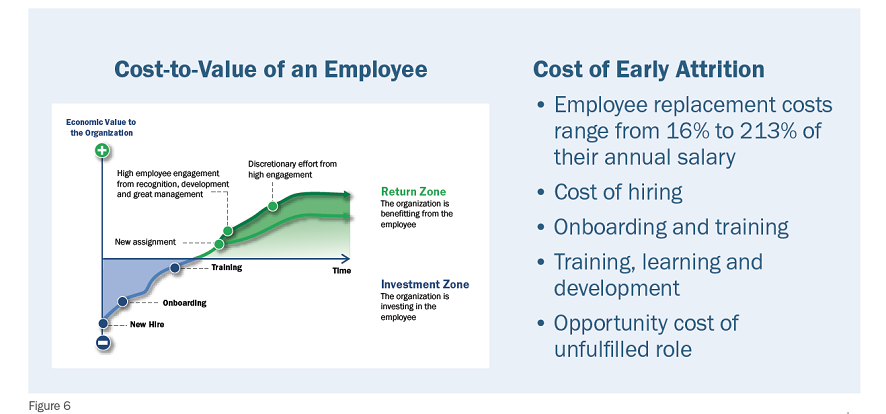
Download
 hbspt.cta.load(123973, 'dec7014e-ac0a-49d2-ae23-b742ac4d9e97', {"useNewLoader":"true","region":"na1"});
hbspt.cta.load(123973, 'dec7014e-ac0a-49d2-ae23-b742ac4d9e97', {"useNewLoader":"true","region":"na1"});
Building An Early Retention Program
For most organizations, labor is the single greatest cost. At a time when more than half of all new hires are considering quitting within the first six months, a pragmatic approach to new hire retention is vital. Unfortunately, many organizations don’t proactively plan for pre-hire success and optimize post-hire experiences. Shown below are eight steps to consider implementing to avoid being in a perpetual state of recruiting for the same positions.
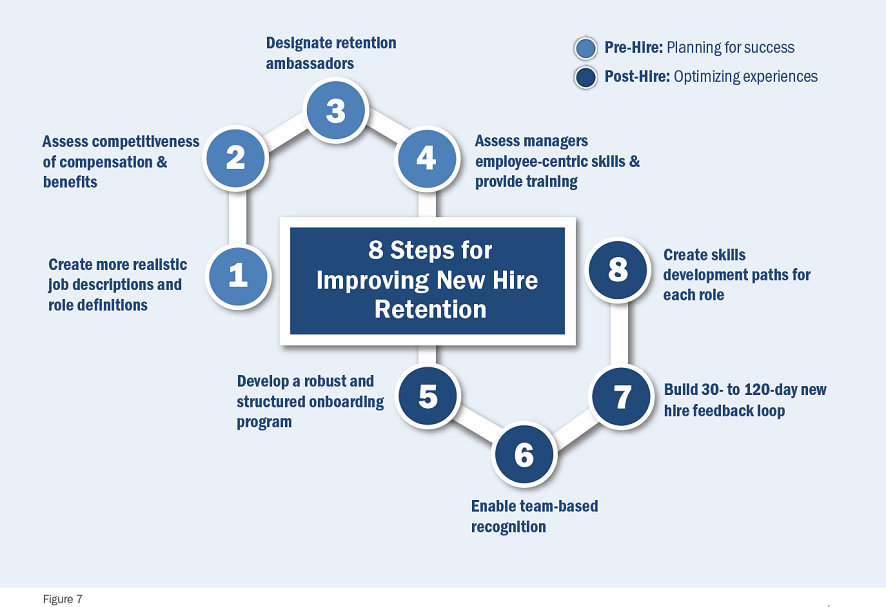
Download
 hbspt.cta.load(123973, 'dec7014e-ac0a-49d2-ae23-b742ac4d9e97', {"useNewLoader":"true","region":"na1"});
hbspt.cta.load(123973, 'dec7014e-ac0a-49d2-ae23-b742ac4d9e97', {"useNewLoader":"true","region":"na1"});